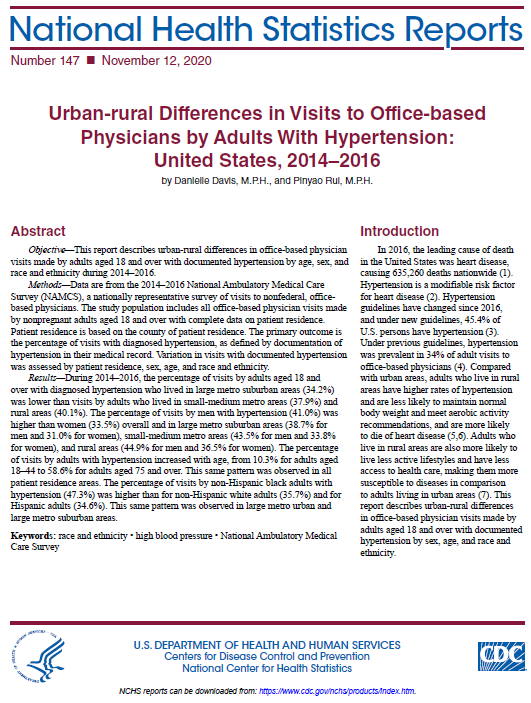Urban-rural Differences in Visits to Office-based Physicians by Adults with Hypertension: United States, 2014–2016
Posted on by Questions for Danielle Davis, Health Statistician and Lead Author of “Urban-rural Differences in Visits to Office-based Physicians by Adults With Hypertension: United States, 2014–2016.”
Questions for Danielle Davis, Health Statistician and Lead Author of “Urban-rural Differences in Visits to Office-based Physicians by Adults With Hypertension: United States, 2014–2016.”
Q: Why did you decide to research urban-rural differences in visits to office-based physicians by adults with hypertension?
DD: During grad school, I worked on a project with the Baltimore City Health Department where I learned about racial disparities in Hypertensive Disorders of Pregnancy. Black women, and sometimes their babies were dying from this disorder without concrete reasons as to why. Some of the women had never been diagnosed with hypertension or other risk factors but would still develop this disorder. It led us to looking at other causes, such as environmental and residential stressors considering these women live in a unique urban setting. I decided to take this knowledge and look at hypertension in the US population as a whole to see how hypertension differed by urban-rural residences.
Q: Was there a specific finding in the data that surprised you from this report?
DD: It was surprising to see a significantly higher percentage of hypertension in non-Hispanic Black adults in Large metro urban and large metro suburban counties in comparison to non-Hispanic White and Hispanic adults.
Q: How did you obtain this data for this report?
DD: Data are from the 2014–2016 National Ambulatory Medical Care Survey (NAMCS), a nationally representative survey of visits to nonfederal, office-based physicians. This data is collected by the National Center for Health Statistics.
Q: Is this the most recent data you have on this topic?
DD: Yes. This is the most recent data we have on this topic.
Q: What is the take home message for this report?
DD: I think the take home message for this report is visits by adults who lived in large metro suburban areas was lower than visits by adults who lived in small-medium metro areas and rural areas. Visits by men with hypertension was higher than visits by women overall, in large metro suburban areas, small medium metro areas, and rural areas. The percentage of visits with hypertension increased with age and was observed in all areas. Lastly, the percentage of visits by non-Hispanic Black adults with hypertension was higher than visits for non-Hispanic White adults and for Hispanic adults. The same pattern was observed in large metro urban and large metro suburban areas.
Posted on by

